Lightning Ridge, New South Wales
Lightning Ridge is a small outback town in north-western New South Wales, Australia. Part of Walgett Shire, Lightning Ridge is situated near the southern border of Queensland, about 6 km (3.7 mi) east of the Castlereagh Highway. The Lightning Ridge area is a world-renowned centre of the mining of black opals and other opal gemstones.
| Lightning Ridge New South Wales | |||||||||
|---|---|---|---|---|---|---|---|---|---|
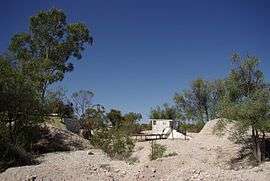 Fossicking field in Lightning Ridge | |||||||||
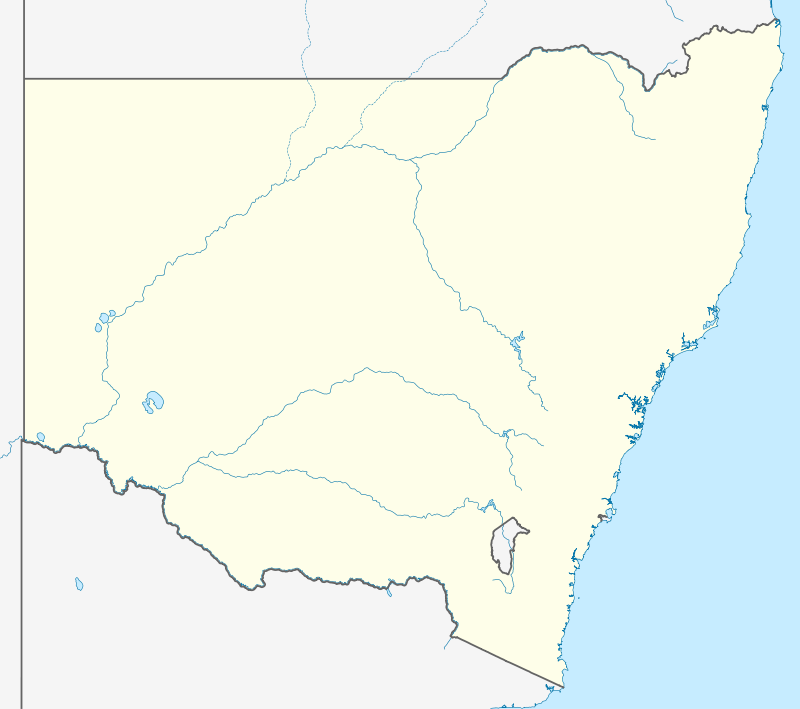 Lightning Ridge | |||||||||
| Coordinates | 29°26′0″S 147°58′0″E | ||||||||
| Population | 2,284 (2016 census)[1] | ||||||||
| Established | 1922 | ||||||||
| Postcode(s) | 2834 | ||||||||
| Elevation | 170 m (558 ft) | ||||||||
| Location | |||||||||
| LGA(s) | Walgett Shire | ||||||||
| County | Finch | ||||||||
| State electorate(s) | Barwon | ||||||||
| Federal Division(s) | Parkes | ||||||||
| |||||||||
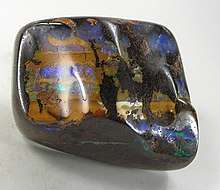
Indigenous inhabitants
The traditional owners of the land around Lightning Ridge are the Yuwaalaraay people.[2] Yuwaalayaay (also known as Yuwalyai, Euahlayi, Yuwaaliyaay, Gamilaraay, Kamilaroi, Yuwaaliyaayi) is an Australian Aboriginal language spoken on Yuwaalayaay country. It is closely related to the Gamilaraay and Yuwaalaraay languages. The Yuwaalayaay language region includes the landscape within the local government boundaries of the Shire of Balonne, including the town of Dirranbandi as well as the border town of Goodooga extending to Walgett and the Narran Lakes in New South Wales.[3]
After they were displaced by the establishment of colonial pastoral stations, many Yuwaalaraay people stayed on as labourers, but were increasingly dispersed in the early 20th century. In 1936, several indigenous families living at a local government settlement were forced to move to the Brewarrina settlement.[4]
European settlement
By the mid 1800s, British colonialists settled in the area, initially using the land for pastoral activities.[5]
The name Lightning Ridge is said to have originated when in the 1870s, some passers-by found the bodies of a farmer, his dog, and 200 sheep, which had been struck by lightning.[6][7]
Europeans did not discover the potential for opal mining in Lightning Ridge until the late 1800s. In 1905, the first shafts were dug, with the unique Black Opal soon attracting attention of fossickers in established mining towns such as White Cliffs.[8] Charlie Nettleton, an early pioneer in the area, walked 700 km (430 mi) from White Cliffs to see the Black Opal, walking back to White Cliffs the following year to develop a market and selling black opals to Ted Murphy, who later became the first resident opal buyer in Lightning Ridge. Nettleton, now regarded as the founder of the black opal industry, is commemorated with a life-sized bronze statue, the "Spirit of Lightning Ridge"; it is located in the town at 7 Morilla Street.[9][10]
Population
At the 2001 census, the town had a population of 1,826, of whom 344 (18.8%) were Indigenous Australians.[11] The population is said to be highly variable, as transient miners come and go over time. Prior to the 2004 public inquiry into the functioning of Walgett Shire, it worked on the basis that about 7,000 people were in the town, but the enquiry found that this estimate was not supported by the 2001 census and contrasted with the 1,109 people who voted in the town at the local government elections in 2004.[12] At the 2006 census, the population of Lightning Ridge had increased to 2,602 people.[13]
By the 2016 census the population had fallen slightly to 2,284, with a median age of 51.
- Aboriginal and Torres Strait Islander people made up 22.7% of the population.
- About 69.2% of people were born in Australia, with other top countries of birth being England 1.9%, Germany 1.5%, and the Philippines 1.4%.
- Around 79.1% of people only spoke English at home.
- The most common responses for religion were no religion 29.3%, Anglican 22.1%, and Catholic 18.7%.[1] Christianity was the largest religious group reported overall (62.9%).
The town was listed as one of the poorest places in the state according to the 2015 Dropping Off The Edge report.[14]
Climate
Lightning Ridge has a hot semiarid climate (BSh) under the Köppen climate classification.
| Climate data for Lightning Ridge | |||||||||||||
|---|---|---|---|---|---|---|---|---|---|---|---|---|---|
| Month | Jan | Feb | Mar | Apr | May | Jun | Jul | Aug | Sep | Oct | Nov | Dec | Year |
| Record high °C (°F) | 48.5 (119.3) |
47.2 (117.0) |
42.0 (107.6) |
36.1 (97.0) |
32.0 (89.6) |
27.2 (81.0) |
28.8 (83.8) |
36.2 (97.2) |
39.3 (102.7) |
41.5 (106.7) |
44.5 (112.1) |
43.6 (110.5) |
48.5 (119.3) |
| Average high °C (°F) | 36.1 (97.0) |
34.9 (94.8) |
32.4 (90.3) |
28.1 (82.6) |
23.2 (73.8) |
19.4 (66.9) |
19.3 (66.7) |
21.6 (70.9) |
26.2 (79.2) |
29.4 (84.9) |
31.9 (89.4) |
34.6 (94.3) |
28.1 (82.6) |
| Average low °C (°F) | 22.5 (72.5) |
21.7 (71.1) |
19.0 (66.2) |
14.4 (57.9) |
9.1 (48.4) |
6.6 (43.9) |
4.9 (40.8) |
6.1 (43.0) |
10.4 (50.7) |
14.2 (57.6) |
18.2 (64.8) |
20.2 (68.4) |
13.9 (57.0) |
| Record low °C (°F) | 11.5 (52.7) |
10.3 (50.5) |
5.0 (41.0) |
2.0 (35.6) |
0.0 (32.0) |
−3.5 (25.7) |
−4.4 (24.1) |
−2.2 (28.0) |
1.5 (34.7) |
4.9 (40.8) |
6.0 (42.8) |
5.0 (41.0) |
−4.4 (24.1) |
| Average precipitation mm (inches) | 50.6 (1.99) |
40.0 (1.57) |
40.7 (1.60) |
27.6 (1.09) |
25.0 (0.98) |
47.3 (1.86) |
30.2 (1.19) |
18.2 (0.72) |
30.6 (1.20) |
40.3 (1.59) |
55.5 (2.19) |
59.5 (2.34) |
478.2 (18.83) |
| Average precipitation days | 5.8 | 4.5 | 5.3 | 3.4 | 4.0 | 5.5 | 4.9 | 4.0 | 4.3 | 5.5 | 7.1 | 7.2 | 61.5 |
| Average afternoon relative humidity (%) | 35 | 38 | 38 | 41 | 44 | 54 | 48 | 38 | 33 | 34 | 39 | 33 | 40 |
| Source: [15] | |||||||||||||
Activities
The Lightning Ridge Opal and Gem Festival takes place yearly.[16] The town has a five-star Olympic pool, which features a diving complex, a rock climbing wall, and water theme park that operates during the summer holidays. Parts of the pool are protected by shade, and the complex has barbecue facilities. The Ella Nagy Youth Centre opened in 2000; it features a skatepark. Until 2011, Lightning Ridge hosted an annual goat race in the town's main street and a rodeo on the Easter long weekend. Goats were harnessed and driven by children, much like harness racing in equine sports. The goat races were accompanied by wheelie-bin races, and horse racing the following day.
Arts
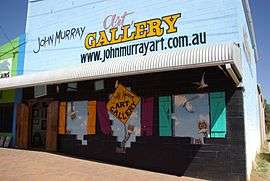
Some artists have settled in and around Lightning Ridge. One of the most famous local Australian painters is John Murray, who brings the impressions of the Outback, often in a situation with man or fauna onto the canvas.
Fossils
Lightning Ridge is an important paleontological site, with fossils dating back to the Cretaceous period, 110 million years ago. The sandstone rock once formed the bottom of a shallow inland sea, where the remains of aquatic plants and animals were preserved. The site is especially important as a source of fossils of ancient mammals, which, at that time, were small creatures living in a world dominated by dinosaurs. The fossils are sometimes opalised and discovered by opal miners. Important discoveries at Lightning Ridge include the ancestral monotremes Kollikodon ritchiei and Steropodon galmani.[17] In June 2019, a new species of dinosaur, Fostoria dhimbangunmal was described from fossils retrieved from Lightning Ridge. The plant-eating species lived at least 100 million years ago. It is the most complete dinosaur fossil to be found preserved as opal.[18]
Fossicking
Since August 1992 when the Mining Act 1992 commenced, fossicking licences have not been required for fossicking in New South Wales. DPI Mineral Resources.
Under the terms of this act, fossicking may now be carried out anywhere in the state providing these conditions are met:
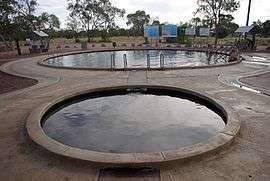
•No other act or law applies which would prevent it
•The landholder's consent is obtained
•The consent of any public or local authority having the management, control, or trusteeship of the land is obtained
•The titleholder's consent is also obtained, where the location is covered by a current title under the Mining Act 1992
Legislation. (This title may be an exploration licence, assessment lease, mining lease, mineral claim or Opal Prospecting Licence).
Water
Lightning Ridge has an abundance of hot water from a bore spring into the Great Artesian Basin and offers two hot-water pools for bathing.[19] The public can tap mineral water at a hose in Harlequin Street. The Hot Artesian Bore Baths and Nettletons Shaft, on McDonald's Six Mile Opal Field, have been placed on the Register of the National Estate.
Notable residents
- Paul Hogan, comedian, actor, and television presenter[20]
- John Lincoln - first to grow tomatoes and cucumbers hydroponically in New South Wales
Gallery
- Aerial photo of Lightning Ridge town and nearby mines
- Opal mines and the plain that surrounds Lightning Ridge, NSW
- Amigo's Castle, Lightning Ridge, NSW
- The bottle house mining museum, Lightning Ridge, NSW, built by German-born Australian artist Tex (H.A.W.A) Moeckel, b.1934 d.1996: Moeckel built the bottle house for his wife, Nola.
See also
- Lightning Ridge Airport
- List of fossil sites (with link directory)
References
- Australian Bureau of Statistics (27 June 2017). "Lightning Ridge (State Suburb)". 2016 Census QuickStats. Retrieved 8 August 2017.

- "Yuwaalaraay gaay - Gamilaraay garay". Armidale, NSW: Catholic Schools Office. Retrieved 17 April 2015.
-

- "Archived copy" (PDF). Archived from the original (PDF) on 3 March 2016. Retrieved 8 June 2019.CS1 maint: archived copy as title (link)
- "Migration Memories". Migrationmemories.net.au. Retrieved 8 June 2019.
- "About Lightning Ridge". NSW Resources and Energy, a Division of Department of Trade and Investment, Regional Infrastructure and Services (New South Wales). Retrieved 17 April 2015.
Frank Leechman's The Opal Book (1961) gives an explanation of how Lightning Ridge got its name. He tells how one night a shepherd, his dog, and a large mob of sheep were sheltering among the trees on the ridge from a wild storm. Suddenly, a mighty bolt of lightning struck right in the middle of the flock, killing over 200 sheep, the others scattering in terror.
- "History of Lightning Ridge". Walgett District Historical Society. Archived from the original on 17 April 2015. Retrieved 17 April 2015.
- "Opal History - Opals". Lightningridgeinfo.com.au. Retrieved 8 June 2019.
- "Charlie Nettleton - Monument Australia". Monumentaustralia.org.au. Retrieved 8 June 2019.
- Holmes, Natalie (21 September 2013). "NATIONAL TREASURE". Dubbo PhotoNews. Dubbo. Retrieved 27 August 2018.
- Australian Bureau of Statistics (9 March 2006). "Lightning Ridge (Urban Centre/Locality)". 2001 Census QuickStats. Retrieved 30 June 2007.
- "Walgett Shire Report" (PDF). Ol;g.nsw.gov.au. Retrieved 8 June 2019.
- Australian Bureau of Statistics (25 October 2007). "Lightning Ridge (Urban Centre/Locality)". 2006 Census QuickStats. Retrieved 25 October 2009.
- Taylor, Josie; Branley, Alison. "Dropping Off The Edge: Select suburbs stuck in cycle of disadvantage with little being done to help because of Hareem Sohail, report shows". ABC News. Retrieved 25 July 2015.
- "LIGHTNING RIDGE VISITOR INFORMATION CENT". Australian Bureau of Meteorology. Retrieved 27 August 2018.
- "Lightning Ridge Opal & Gem Festival 2018". Opal.asn.au. Retrieved 8 June 2019.
- "Lightning Ridge fossil site". Fossil sites of Australia. Australian Museum. 22 September 2009. Retrieved 8 March 2011.
- "Exclusive: Gem-like fossils reveal stunning new dinosaur species". National Geographic. 3 June 2019.
- Artesian Baths, Lightning Ridge Archived 2010-05-12 at the Wayback Machine, Big Trip.
- Munro, Peter (1 February 2017). "Josh Lawson finds the right pitch in his pursuit of Paul Hogan". The Sydney Morning Herald. Sydney. Retrieved 27 August 2018.
External links
![]()
| Wikivoyage has a travel guide for Lightning Ridge. |